Labradoodles, known for their playful demeanor and curly locks, are more than just adorable pets; they are part of our families. As a Labradoodle owner, one of the most crucial decisions you’ll face is determining the best diet for your Labradoodle.
The best diet for Labradoodles is a diet rich in high-quality proteins like chicken, beef, venison, duck, or fish, essential for their active lifestyle. Complementing these proteins with grains, fruits, and vegetables such as brown rice, apples, peas, and carrots, adds vital nutrients to their meals.
In this blog, we’ll delve into the world of canine nutrition, specifically tailored for Labradoodles, to help you understand what fuels these energetic and loving dogs.
From understanding their unique dietary needs to navigating the myriad of food options available, we’re here to guide you through the journey of ensuring your Labradoodle gets the nutrition they deserve.
Join us as we explore the best diet for Labradoodles, ensuring your four-legged friend stays happy, healthy, and thriving.
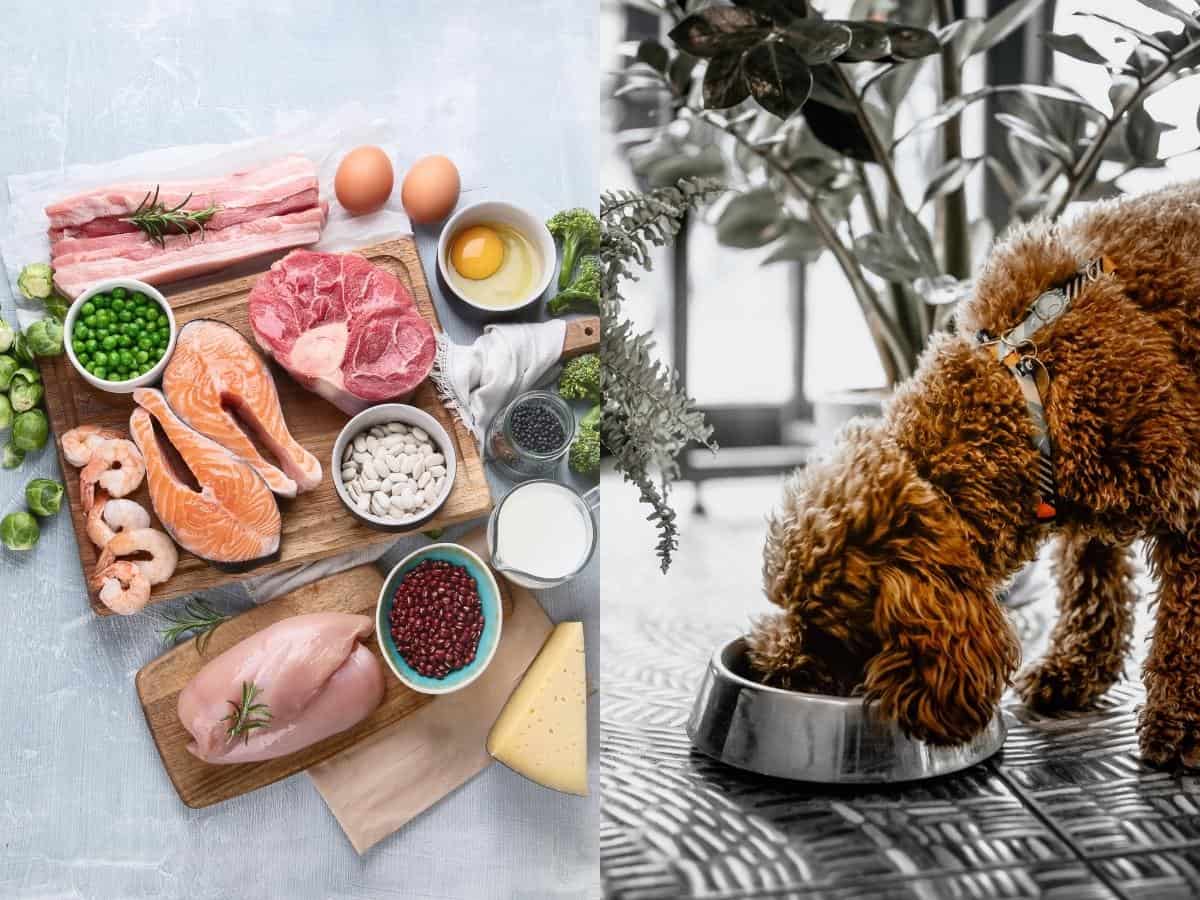
Nutritional Needs of Labradoodles
As a new Labradoodle parent, knowing what to feed your puppy can be challenging. Where exactly do you begin when there are so many options?
Let’s clarify what you need to know about the ideal diet for Doodles to keep your dog well-fed, active, and healthy.
Labradoodles are medium-sized dogs. You will almost always see a female Labrador coupled with a male Poodle when breeding Labradoodles since the female needs to be the larger of the two to ensure a safe birth. Consequently, Labradoodles are almost the same size as the standard Labrador.
DID YOU KNOW? Occasionally, Miniature or Toy Poodles are used in the breeding process, and these will, of course, be smaller.
Medium-sized dogs generally need more protein than smaller breeds. But they also need a decent amount of carbs and healthy fats.
Considering Labradoodles were developed as working dogs, they need an excellent diet to sustain their energy needs and brain power.
Labradoodles need a high-quality, protein-rich diet comprising 18-22% protein. Additionally, they can obtain nutrition from grains, fruits, and vegetables.
However, Doodles must ensure they have the proper proportions of protein, fats, carbs, and fiber to sustain their limitless energy.
Knowing the macronutrients your Labradoodle needs is pivotal to providing food that can support his growth as a pup and help maintain his energetic and playful nature.
Without the correct ratio of protein to fat or protein to carbs, your Doodle might become overweight or even malnourished.
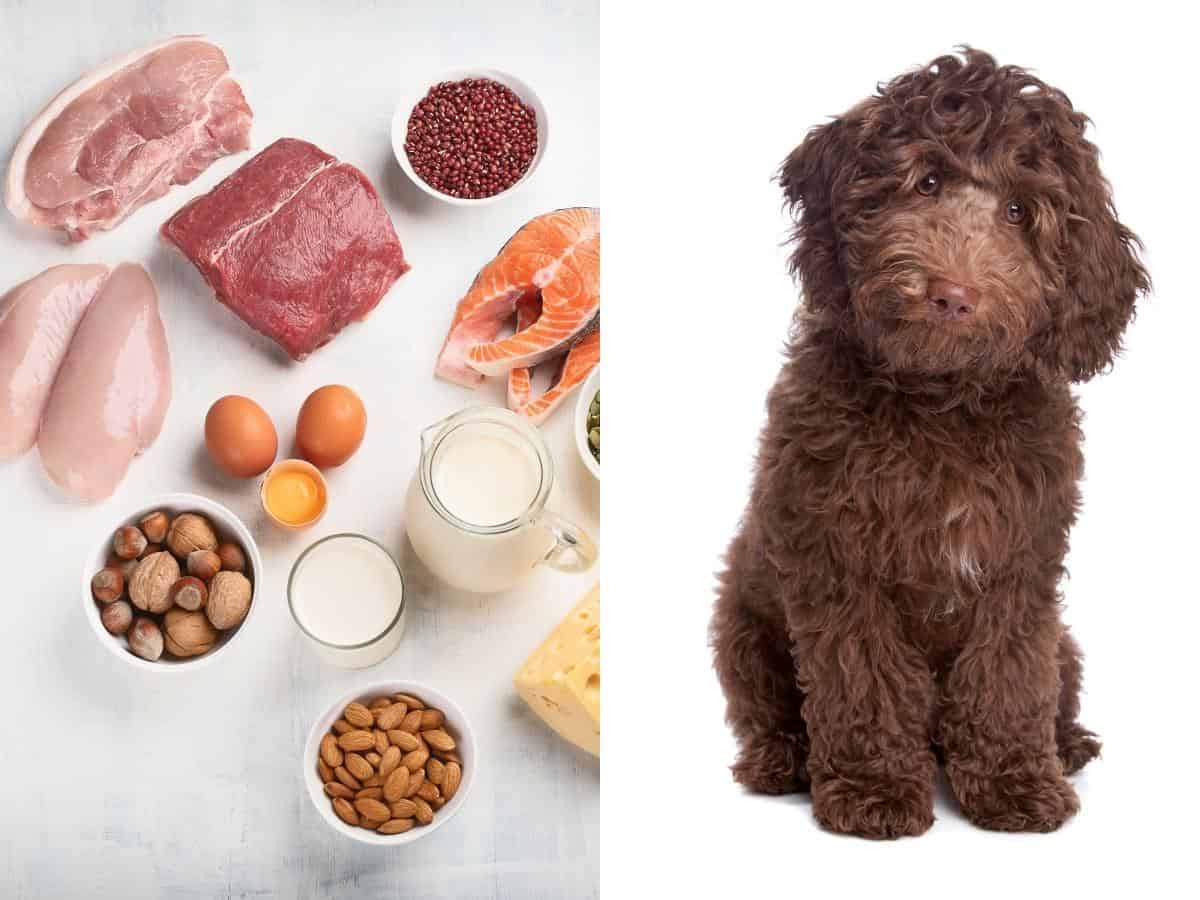
What you feed your Labradoodle also depends on their age. Puppies, adults, and seniors all have different nutritional needs.
When reading pet food labels, you must choose a diet according to your dog’s life stage. You can supplement a Labradoodle’s diet with multivitamins, joint support, and probiotics.
Protein and Fat Ratios
The Association of American Feed Control Officials (AAFCO) determines the minimum requirements for the nutritional adequacy of dog food. The documentation can be somewhat lengthy, so here is my condensed version:
Labradoodle puppies and pregnant or lactating females need a minimum of 22% protein and 8% fat, whereas adults need a minimum of 18% protein and 5% fat.
| Life Stage | Protein (Minimum) | Fat (Minimum) |
|---|---|---|
| Gestation/Lactation | 22% | 8% |
| Growth (puppies) | 22% | 8% |
| Adult Maintenance | 18% | 5% |
| All Life Stages*** | 22% | 8% |
***A Labradoodle diet designed for “all life stages” simply means one that meets the nutritional requirements for any life stage, whether reproduction, growth, or adult.
Other age-related feeding considerations are:
- Labradoodle Puppies – Hip dysplasia is quite common across several medium-large breeds. It is when the thigh bone no longer fits properly in the hip joint and can result in arthritis and lameness. Labradoodles are prone to hip dysplasia; they mustn’t have too much excess calcium in their diet when growing, which can increase the risk of joint issues later in life.
- Senior Labradoodles – Some older dogs may need more protein than their younger counterparts and may suit a diet with a higher protein-to-calorie ratio. Older dogs with osteoarthritis may benefit from weight management and nutrients that reduce inflammation, such as Omega-3 fatty acids. Always check with your vet first for the best way forward for your pet.
Your Labradoodle’s diet will also have distinct nutritional needs depending on size, activity level, and overall health. For example:
- A Labradoodle puppy that is active and growing may require twice as many calories as an adult.
- A pregnant or breastfeeding bitch will need a lot more food.
- A senior Labradoodle may require 15-20% fewer calories per day than a dog of similar age.
Thankfully, dog food production has advanced so that you no longer need to plan your dog’s diet like a Hollywood actor attempting to shed 28 pounds for a role.
You simply need the basic information to choose the ideal dog food package for your Labradoodle – and I present that information here.
Foods For Labradoodles
Dogs’ digestive systems differ from humans. As a result, several foods that are healthy for humans may be toxic for dogs. When selecting safe and nutritious food items for your Labradoodle, you must know your options.
Labradoodles can eat most meat/protein, including lamb, beef, chicken, turkey, pork, fish, and eggs. They can also digest plant-based proteins such as veggies, grains, and legumes. Fruit pieces, other than grapes, are also nutritious.
We’ll review grapes and their dried variants in the “can’t eat” section below. But first, let’s explore each food option that Labradoodles can have in their diet.
Best Diet For Labradoodles
Lamb
Labradoodles can eat lamb, and it is a holistic primary food source for a dog. It contains essential amino acids and dietary fat to sustain growth and energy and build healthy muscles, skin, and coats.
It also contains vital vitamins and minerals and is easy for dogs to digest.
With a few fruit-driven carbs in your Labradoodle’s diet, he can survive on an entirely raw and organic diet if your wallet can survive this feeding choice. You can, of course, choose to cook the meat if you prefer.
Beef
Labradoodles can eat beef. Lean beef is an excellent protein source in many dog foods. It contains various nutrients such as vitamin B6, B12, selenium, zinc, iron, riboflavin, and phosphorus.
Beef helps maintain and build muscle mass, promotes a shiny coat, and prevents anemia.
Beef and lamb don’t differ as much in their macro nutritional value. They differ in taste and price. You can experiment to see which of the two your dog prefers. But similar to a lamb diet, you’ll need external carbs, primarily from grains, fruit, or veggies.
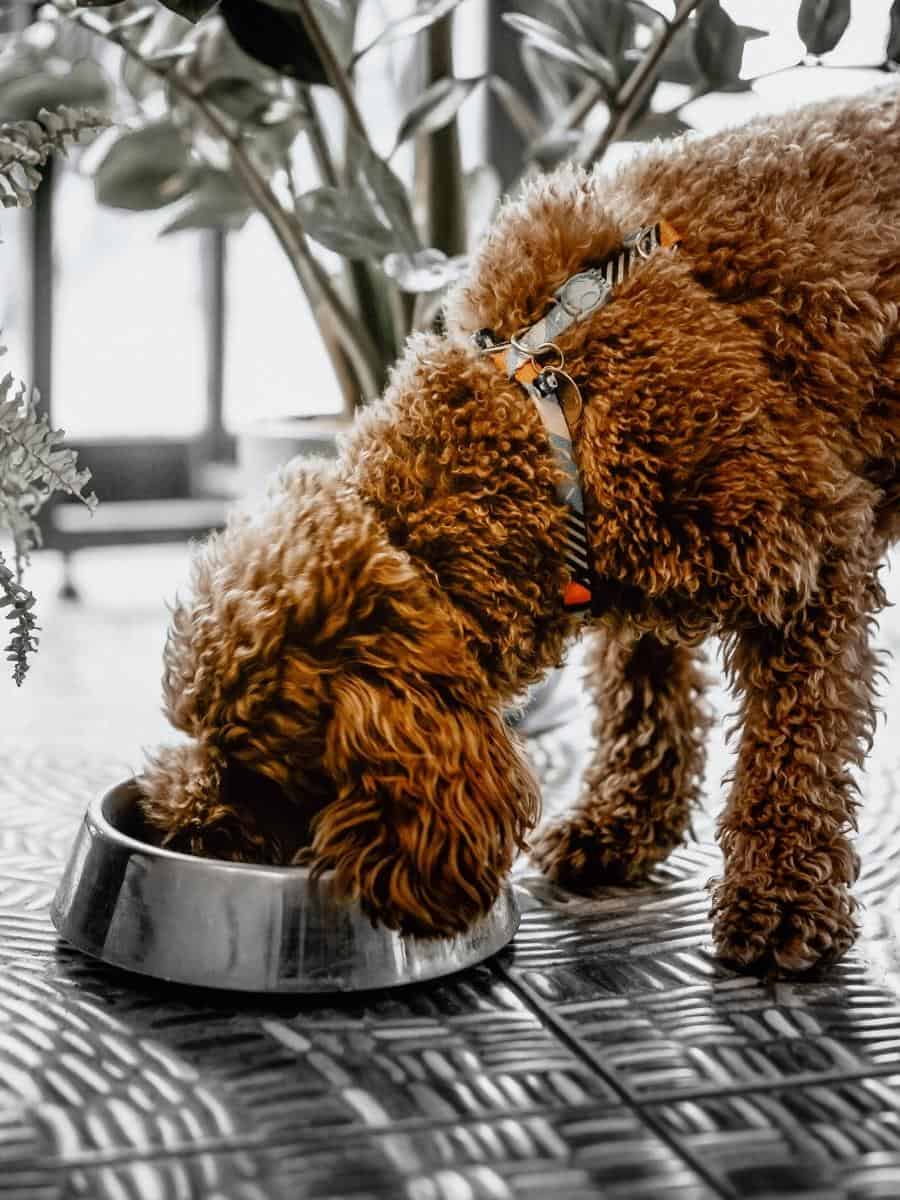
Fish
Labradoodles can eat fish, which is typically pretty healthy and often used as an alternate protein source in dog food.
Sardines are a good choice as they are an excellent source of Omega-3. You can also feed your Labradoodle salmon, sea bass, herring, cod, whitefish, tuna, and mackerel.
Some fish, such as tuna, sea bass, and mackerel, have higher levels of mercury, so feed these in moderation. Be aware, too, that fish can carry parasitic bacteria, which are usually killed in the cooking process.
Moreover, fish bones can be an obstacle, and deboned fish can be expensive. Still, fish should not be the main protein in your dog’s diet, but it is a great addition. My dog loves a little tuna or salmon as a topping on her food.
Pork
Labradoodles can eat plain, cooked pork. Pork is a highly nutritious protein source and is very palatable for dogs. It contains various nutrients such as vitamin B6, B12, selenium, niacin, zinc, iron, and phosphorus.
The proteins in pork are complete amino acids and are the perfect building blocks for making new muscle.
Avoid processed cuts of pork such as bacon, gammon, and sausage, as these are high in fat, salt, and preservatives and will give your dog an upset tummy.
Raw pork is also a ‘no-no’ as it contains trichinella parasites that can infect both canines and humans.
Chicken (and Turkey)
Labradoodles can eat chicken. Chicken (and turkey) are an excellent protein source, providing energy, strong bones and muscles, and plentiful essential vitamins and minerals. They also have Omega-6 fatty acids, which are good for your Labradoodle’s coat and skin.
Both chicken and turkey are primary ingredients in commercial dog food and are kinder on your wallet than lamb or beef. But, if you want the best for your dog, avoid chicken meal and by-products as these contain ground bone, skin, neck, feet, intestines, etc.
Eggs
Eggs are incredibly nutritious for your Labradoodle. They are rich in amino acids, the building blocks of protein. These nutritional powerhouses also contain many nutrients, including iron, vitamin A, B2, B5, B12, folate, phosphorus, calcium, zinc, selenium, and fatty acids.
Eggs also have benefits for arthritic dogs. This study found that eggshell membranes significantly improved joint function and reduced joint pain in dogs, resulting in a better quality of life.
You can feed eggs raw but follow all food safety guidelines to prevent the risk of contracting salmonella. However, the risk is minimal, and dogs have eaten raw eggs for hundreds of years, but you should be aware of the risk and follow best practices.
Grains
Labradoodles can eat grains such as oats, rice, whole wheat, and corn. Dogs are not just carnivores but omnivores and can thrive on a grain-inclusive diet.
Grains contain abundant nutrients and provide carbs, fat, and antioxidants that support a healthy immune system, skin, and coat.
Some grains are more nutritious than others. For example, you should always choose brown rice instead of white. The exception is if your dog has diarrhea, then feed white rice as it helps to bind the stools.
Avoid buying into the myth that grains cause allergies in dogs and that dogs should consume a grain-free diet that some pet food manufacturers have spread.
Food allergies in dogs are uncommon, and dogs are more likely to react to proteins like beef, poultry, or lamb.
| Proteins for Labradoodles | Grains for Labradoodles |
|---|---|
| Beef | Wheat |
| Chicken and Turkey | Rice |
| Venison | Oats and Oatmeal |
| Lamb | Maize |
| Pork | Corn |
| Duck | Barley |
| Liver, Kidney & Heart | Rye |
| Whitefish | Quinoa |
| Salmon | Buckwheat |
| Tuna, Mackeral & Sea Bass | Millet |
| Eggs | Bulgar |
Fruits
Labradoodles can eat fruits such as apples, strawberries, blackberries, bananas, pears, or raspberries. They provide lots of vitamins and minerals to boost their immune system and keep them fit and healthy.
However, no matter how vegan you are, please do not make your Doodle survive on fruits alone. Since fruits have an average of 2% to 6% protein, they cannot replace the protein in your Labradoodle’s diet.
Instead, fruits should be more of a carb supplement in your dog’s diet. Above all, avoid feeding grapes, raisins, and other dried variants as they are toxic.
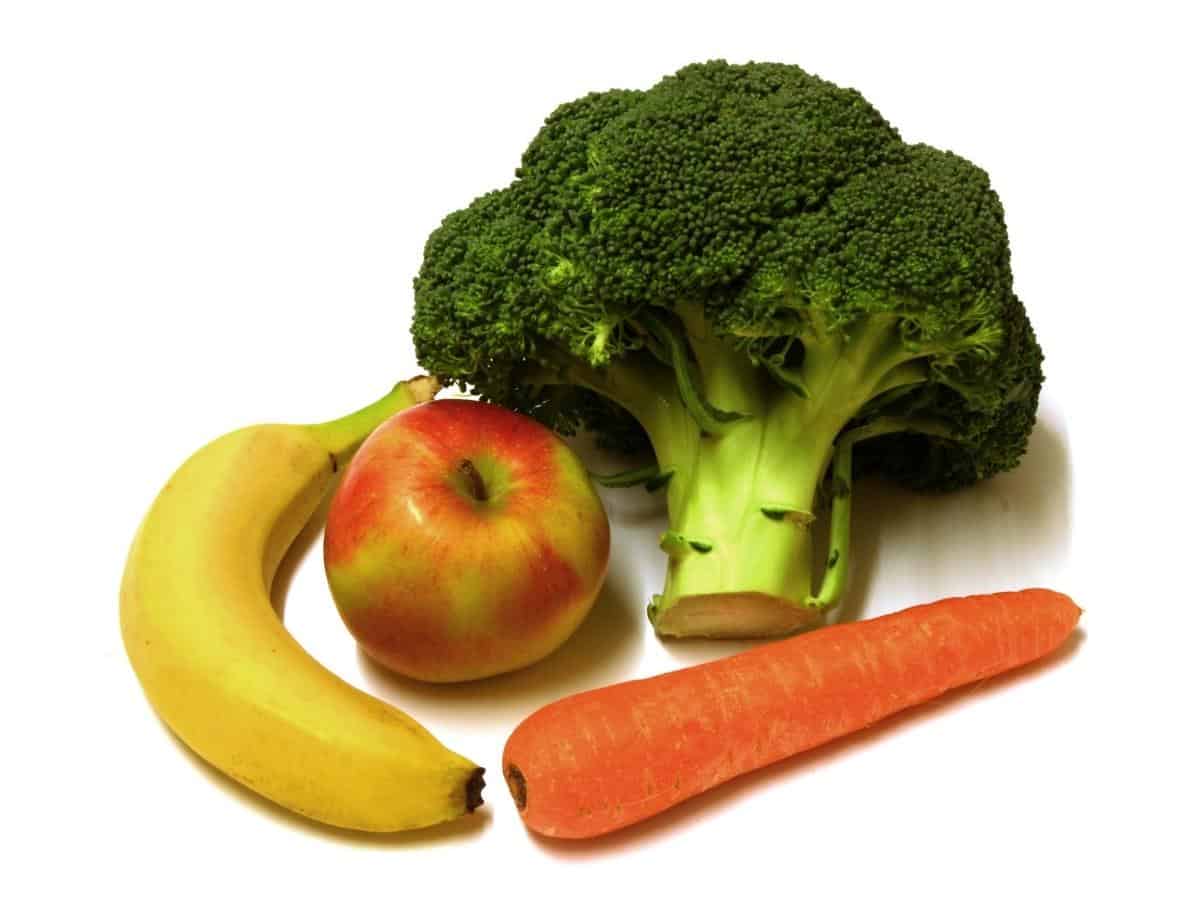
Vegetables
Labradoodles can eat vegetables such as broccoli, green beans, carrots, pumpkin, peas, and sweet potatoes. Veggies are an excellent source of vitamin A, fiber, and potassium. You can feed them cooked, raw, or frozen.
Although carb-rich, they contain more protein than fruit. Still, their macronutrient ratio is not enough to offset meat in your Doodle’s diet, but they can be used as carb supplements, just like fruits.
Labradoodles are usually big fans of carrots as they love to crunch on them. They are also great for improving dental health as they help to keep teeth and gums clean.
| Vegetables for Labradoodles | Fruits for Labradoodles |
|---|---|
| Artichoke | Apple |
| Asparagus | Apricot |
| Bell Peppers | Banana |
| Beets | Blackberries |
| Broccoli & Brussels Sprouts | Blueberries |
| Cabbage & Cauliflower | Coconut |
| Carrot | Cranberries |
| Celery | Cucumber |
| Corn | Dates |
| Cucumber | Kiwi Fruit |
| Eggplant | Mango |
| Green Beans & Peas | Melon |
| Lettuce & Kale | Nectarine |
| Parsnips | Peach & Plum |
| Pumpkin | Persimmon |
| Potato (cooked) | Olive |
| Rutabaga & Turnip | Pear |
| Spinach | Pineapple |
| Sweet Potato | Raspberries |
| Squash | Strawberries |
| Zucchini | Watermelon |
Dairy
If your Labradoodle is not lactose intolerant, he can eat some dairy foods in moderation. Dairy foods provide protein, calcium, vitamin D, A, B12, zinc, magnesium, and selenium. They build strong bones, reduce the risk of diabetes, and may improve heart health.
Experimenting with small amounts of dairy foods is best to see what your dog can handle. Some dogs have trouble digesting milk but can enjoy small pieces of cheese or a blob or two of plain yogurt.
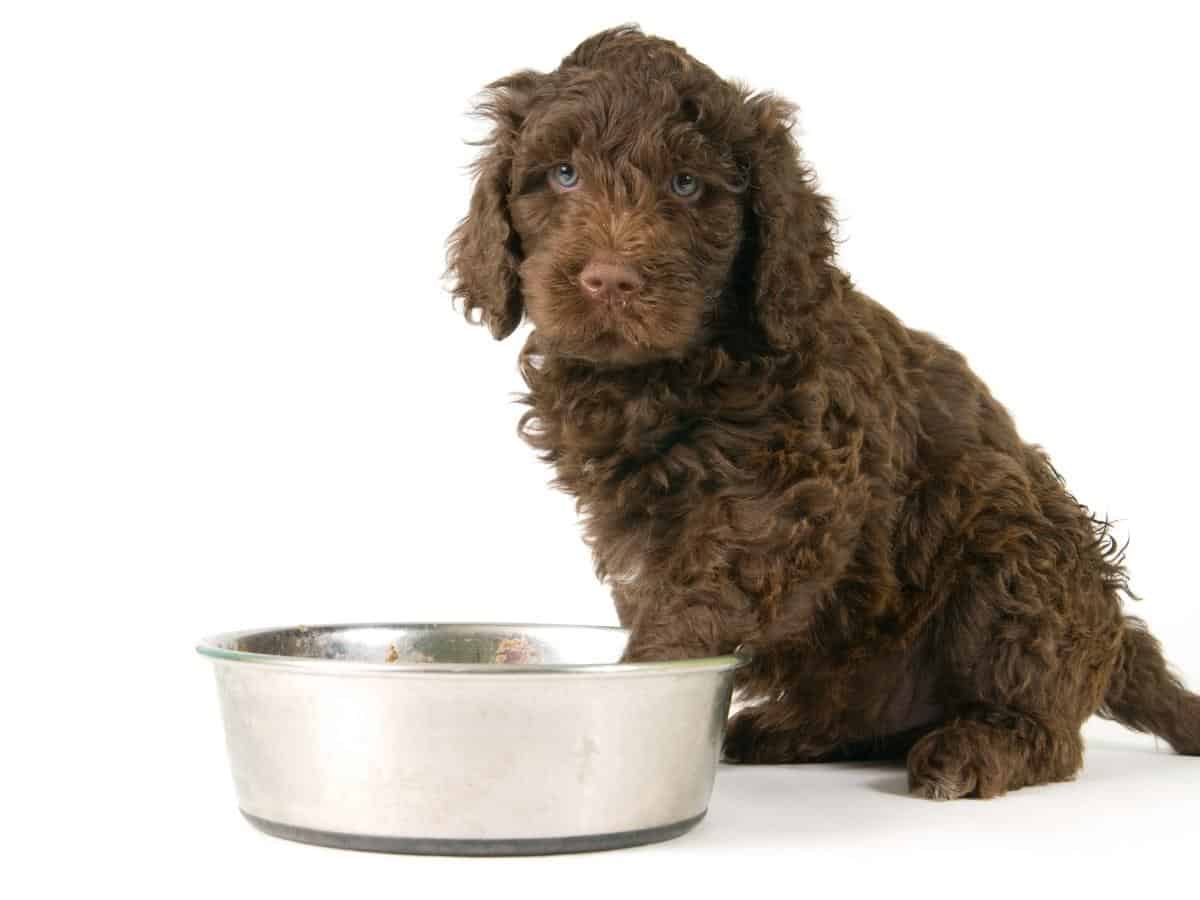
Commercial Dog Food
Aside from the foods listed above, you can also feed your Labradoodle commercial dog food. Labradoodles can eat dry, wet, semi-dry food (technically wet, too), raw, dehydrated, or freeze-dried food.
However, you must be careful not to select a food package for a different breed with macro nutritional requirements other than Labradoodles.
The most remarkable thing about commercial dog food is that it is far less expensive than homemade dog food and takes much less time to prepare, store, and feed.
Foods to Avoid Feeding Your Labradoodle
Labradoodles cannot eat chocolate, macadamia nuts, black walnuts, onion, garlic, grapes, or avocado. Also, keep alcohol, sugar, salty foods, and caffeine out of a Doodle’s diet.
Ensure any fruit pits are out of your dog’s reach, as these are toxic if ingested in high quantities and can cause choking.
The table below covers why you must avoid each “must avoid” food.
| Food | Reasons Your Labradoodle Should Not Eat It |
|---|---|
| Raw fish | Raw fish can carry parasites, and big fish often contain too much mercury. Standard market-packed sardines are the safest fish for dogs. |
| Onion | Onions are poisonous and can damage a dog’s red blood cells, causing anemia. Even onion powder in a broth can have this effect. |
| Garlic | Garlic can also make your dog anemic. Make sure any food you prepare contains no garlic flavor. |
| Chocolate | Theobromine and caffeine in chocolate and chocolate-adjacent products are toxic to dogs. |
| Sweeteners | Products like peanut butter may have xylitol, which can suddenly drop a Labradoodle’s blood sugar. Ensure you choose an organic brand. |
| Grapes (& Raisins) | The biological cause of grape toxicity is yet to be discovered. Still, enough cases of canine kidney failure following grape consumption have been recorded to keep them on the “must avoid” list. |
| Nuts | Some nuts can lead to weakness, vomiting, and tremors. Macadamia and black walnuts are the worst at this. Other varieties are also too high in fat. |
| Cooked bones | These can cause constipation because a dog’s stomach cannot digest them. Raw bones are fair game, though, as long as they’re wider than the muzzle to avoid choking. |
| Avocado | The avocado skin can result in vomiting and diarrhea, so your Labradoodle should be kept away from this fruit. |
| Alcohol | Keep alcohol out of your Labradoodle’s reach because dogs can’t digest alcohol. Your dog can OD on alcohol. |
| Fruit pits | When you feed fruit to your Labradoodle, you need to make sure that you remove the pits as they can block your dog’s intestines or cause choking. |
| Sugar | Dogs love sweet treats, but if you feed a sugar-rich diet, they will get fat. If you don’t want your dog to look like a middle-aged, recently divorced wolf, you should keep sugary treats out of his diet. |
| Yeast Dough | If you bake bread at home, keep your dog away from unbaked dough. It can ferment in the stomach causing alcohol toxicosis, and the yeast can rise in the gut, causing a severe blockage. |
| Moldy Food | Mold contains mycotoxins that are poisonous to canines, so don’t be tempted to give your dog blue cheese or moldy bread – and keep him away from the garbage! |
The list of “must avoid” foods leaves you with two options. The first is to sit down and curate a Labradoodle diet that dodges the above. The second is to simply opt for packaged dog food.
Curating an organic diet for your Labradoodle is difficult because many “allowed foods” are conflicting:
- You can feed your Doodle fruits – but keep the pits away.
- You can offer your dog potatoes – as long as they’re not raw or green.
- Specific fruits- especially grapes and starfruit- can be toxic to your Labradoodle.
- You can feed your dog veggies – yet garlic and onion can be problematic.
- You can provide your dog fish – but not if it is completely raw.
However, organic food is healthier than extruded kibble cooked at high temperatures, which reduces its nutritional value. On the other hand, packaged dog food is easy to get, feed, and store.
Types of Dog Foods
Now that we have covered specific foods that Labradoodles can and can’t eat, let’s look at the many types of dog food you can feed your Doodle.
Learn All About Dog Food Types In This Video…
Dry (Kibble)
Dry dog food is preferred by most Labradoodles while being rejected by others. As long as it is lower in calcium for puppies and is top quality, dry dog food is specially formulated to fuel a Doodle’s energy needs.
Dry food is less expensive, lasts longer, and doesn’t need refrigeration. You can leave it out for hours, and it won’t get spoiled.
If you’re looking for an estimation of monthly costs, check out my recent research here: How Much Does Dog Food Cost a Month?
Kibble is also good for your dog’s teeth as it cleans them along the way, helping stave off tooth and gum problems.
Wet (Canned)
If your Labradoodle turns his nose up at dry kibble, you can try wet dog food as it contains much higher moisture content than dry food. Some larger dogs like it, whereas others prefer a bit of crunch.
Take note, though, that canned wet food can be expensive for dogs the size of Labradoodles, as you will need to provide much more.
Ensure you check the protein content, as wet food contains a lot of water. But it may suit dogs that don’t drink much water, struggle with hydration, or have urinary problems.
Dry and Wet Mix
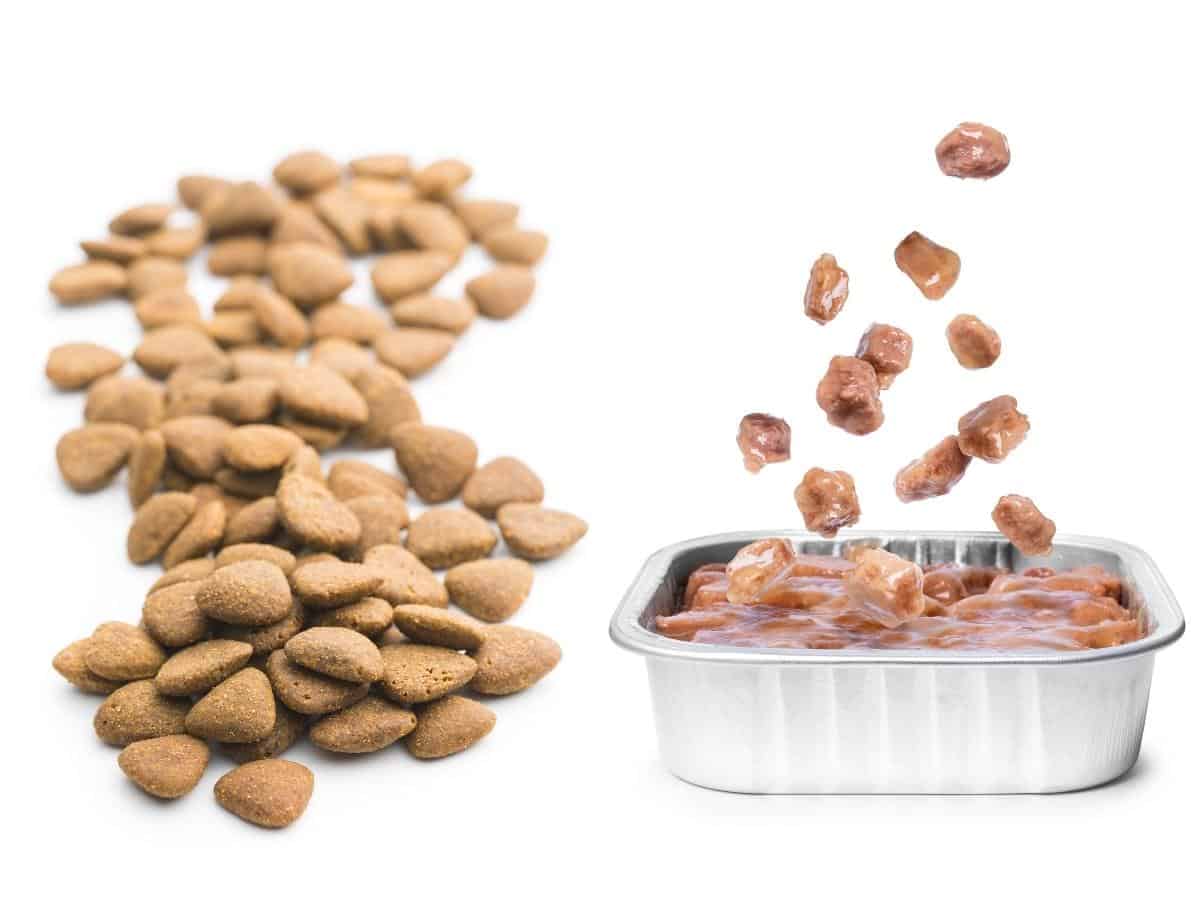
This is one of the most widely preferred Labradoodle food types, and you get the best of both worlds. Most Doodles who dislike dry or wet food like a wet and dry mix.
Adding a few scoops of wet food to dry food changes the texture and palatability of the food, making it enticing to your dog.
You can also add water to dry dog food, making it easier to digest and more appetizing, especially if you have a fussy eater or a dog with general appetite loss due to illness.
I must admit, my dog loves it when I add warm water to her food, which turns it into a tasty “gravy” or “porridge.”
Alternatively, add a topping to the kibble, such as chicken, beef, fruit, veggies, cheese, or plain yogurt. This gives your dog added variety – but remember to adjust the calories accordingly.
You may also consider semi-moist dog food. However, it’s uncommon as it offers the least nutritional value, is expensive, and comes with added sugar and salts to preserve shelf life and moisture.
Homemade
Wet dog food isn’t the exclusive domain of factories. You can use one of countless dog chow recipes to produce homemade dog food. Some dog owners enjoy home cooking for their dogs as it gives them complete control of what they feed them.
However, preparing a homemade diet can also be expensive and very time-consuming.
If you want to be a home feeder, you should consult a canine nutritionist to check your Labradoodle isn’t missing out on any vital nutrients.
Check out the directory of certified vet nutritionists from the American College of Veterinary Nutrition to help you find one in your area.
Raw
Of course, if you grasp the idea of feeding chow made from leftover meat, you can always get your Labradoodle a prime Wagyu steak.
A raw diet comprises raw meat and organs mixed in – and raw bones. This method of feeding your dog has grown in popularity in recent years.
You can prepare a raw diet at home, similar to a home-cooked meal (except raw), or buy pre-prepared complete and balanced raw food, which is more convenient.
If you choose to prepare a raw diet yourself, again, you’ll need to check you’re providing all the right foods in their correct proportions with your vet or a doggy nutritionist.
While weighing up your options, you might want to consider the price of feeding a raw diet. Here’s my latest research to give you food for thought: The Cost To Feed Raw Dog Food (The True Price!)
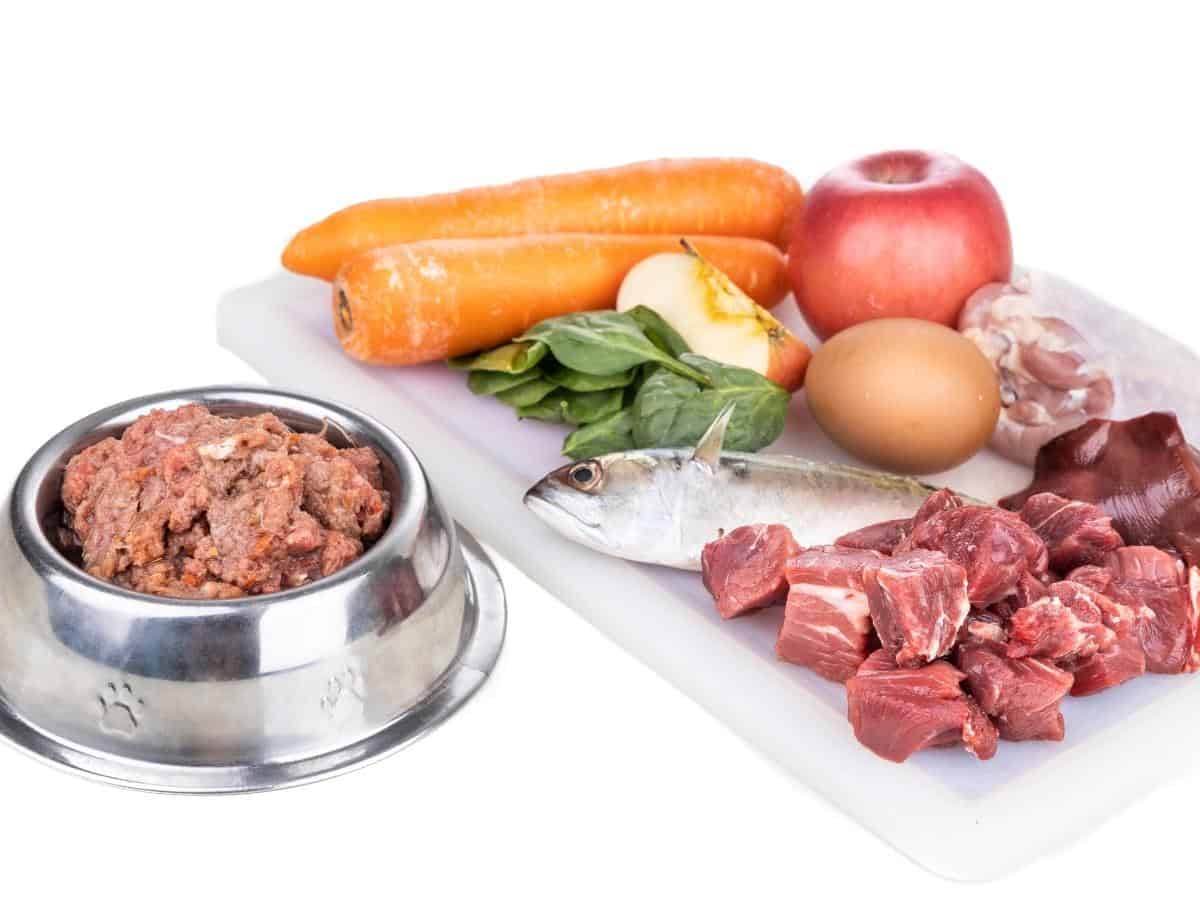
Dehydrated
Dehydrated dog food (also known as air-dried) is often confused with dry dog food because it is technically dry. However, you must add water to get the food into the shape it is intended to be served.
A dehydrated doggy diet is a healthy and minimally processed feeding option as it uses a low-heat and gentle drying method.
It combines the convenience of dry food with the nutritional benefits of raw. It is easier to store and far more portable, but it can be costly.
Freeze-Dried
Freeze-dried dog food is prepared at the factory and brought into its wet form, then freeze-dried into solids that dissolve in the water. It is dehydrated at a lower temperature.
In this way, the nutrients are relatively undamaged, making this diet seemingly the most “organic” form of dry dog food on the market.
Once the food is put in a sealed package, it can take years to degrade because there is no moisture for microorganisms to survive. When you buy freeze-dried dog food, it is still raw. However, it isn’t cheap and is out of reach for most owners’ budgets.
How Much Food Should a Labradoodle Eat?
It’s difficult to figure out how much food to give your dog. Your Labradoodle’s food needs largely depend on his size, age, activity level, metabolism, and overall health.
For example, a Labrador mixed with a Standard Poodle will need far more food than a much smaller Lab mixed with a Toy Poodle.
But as most Labradoodles are medium-sized dogs, here’s a rough guide for a Labradoodle with a reasonable amount of daily exercise:
An adult male Labradoodle needs 2 cups of dog food daily, one per meal. A smaller adult female needs 1.75 cups of dog food split into 2 meals. A Labradoodle puppy needs 12 – 16 ounces of food per day divided into 3 meals initially and then 2 meals at 6 months old.
Labradoodles tend to control their weight pretty well. Most identify when they’re hungry and know when to stop eating.
However, some dogs may be food-motivated and greedy, especially if they carry the POMC mutated gene, which is responsible for an increased appetite in Labradors.
In reality, there’s no easy answer to the question of how much to feed your Labradoodle, but as long as you follow the packaging guidelines, you won’t go far wrong.

Labradoodle Feeding Schedule
You should consider the energy your dog uses during the day when creating a healthy feeding schedule for them. Mini Labradoodles, for example, will burn off energy more quickly than the standard variety.
However, it is advised to offer one cup of dry dog food or its equivalent and then wait eight hours before feeding another cup to avoid canine bloat.
When your Labradoodle is a puppy, you must split his intake into 3 or 4 meals. Feeding your pup can be slightly complicated because of your, and not his, schedule.
You should wait at least 3 hours before introducing the next serving to a puppy’s bowl and avoid feeding your dog right before or after a period of high activity.
Labradoodle Puppy Meal Plan
Puppies need feeding more often, as they need extra calories to grow and satisfy their energy requirements.
Labradoodle puppies should be fed 4 meals a day up to 3 months of age, 3 meals a day up to 6 months of age, and 2 meals a day from 6 months to adulthood.
| Age of Labradoodle | Daily Meals |
| 6 to 12 weeks | 4 |
| 12 to 24 weeks | 3 |
| 24 weeks onwards | 2 |
Final Thoughts
Related Posts You May Like:
Here’s the essence of the best diet for Labradoodles: While these dogs are good at controlling their food intake, they’re not great at avoiding unhealthy choices.
A high-protein diet is essential for their nutritional balance. Remember, good nutrition is vital for your Labradoodle’s health and recovery abilities. When choosing their food, keep these tips in mind:
- Pick a diet suitable for your dog’s life stage.
- Choose dog food that fits your daily schedule.
- Invest in the best quality dog food your budget allows.
Related Posts You May Like:





